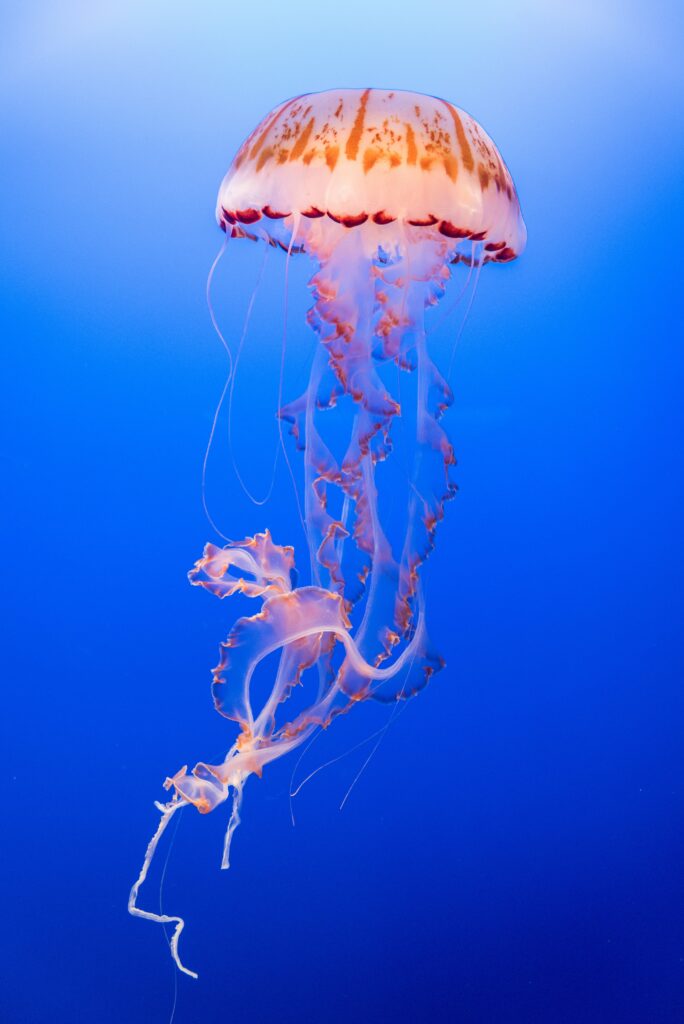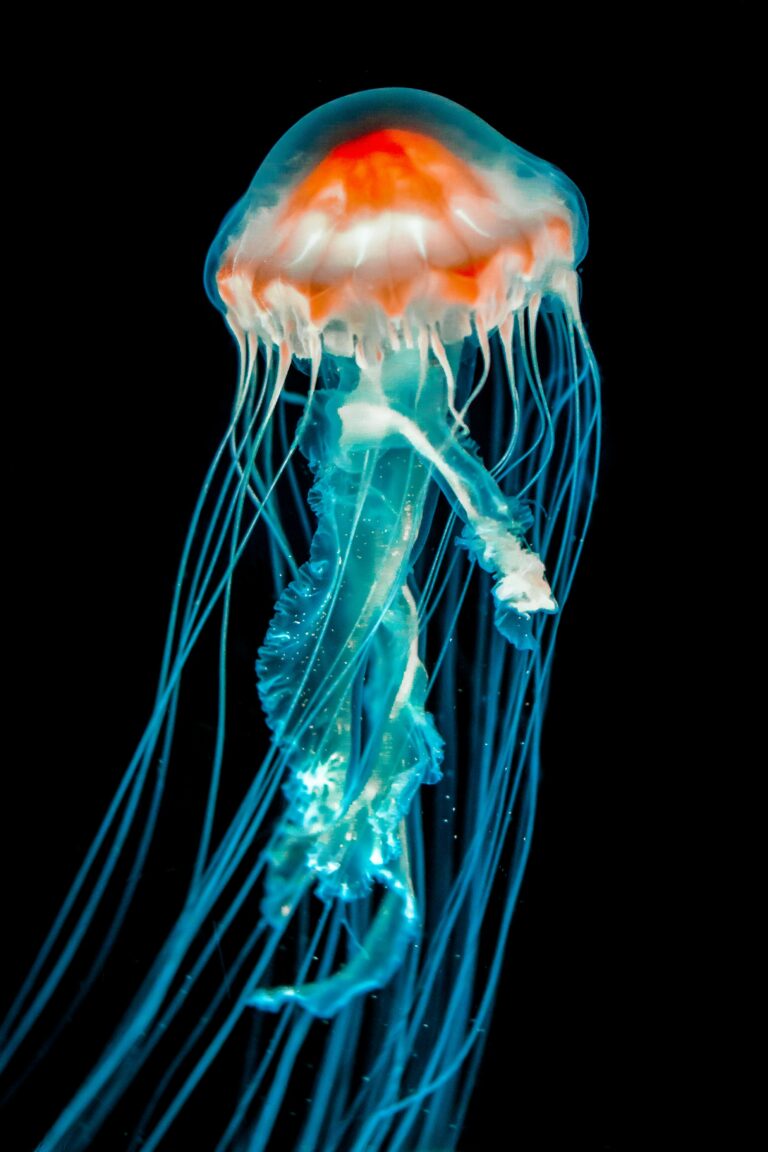Jellyfish, with their ethereal movements and captivating appearances, have long intrigued and mystified both scientists and casual observers alike. These enigmatic creatures, known for their gelatinous bodies and trailing tentacles, play crucial roles in marine ecosystems, yet much about them remains shrouded in mystery. In this article, we delve into the fascinating world of jellyfish, exploring their biology, ecological significance, and the challenges they face in today’s changing oceans.
Anatomy and Physiology
Jellyfish, known scientifically as medusae, are fascinating creatures that belong to the phylum Cnidaria. These gelatinous beings have a unique anatomy and physiology that allow them to thrive in various aquatic environments. Understanding their physical makeup provides insights into their behavior, ecology, and evolutionary adaptations.
External Structure
The body of a jellyfish typically consists of a bell-shaped or umbrella-like structure, known as the medusa, which is transparent and gelatinous. This bell is composed primarily of water (up to 95%) and contains specialized cells called cnidocytes, which are responsible for delivering venom to prey or deterring predators. Surrounding the bell, there are often tentacles equipped with stinging cells called nematocysts, aiding in prey capture and defense. These tentacles vary in length and can be quite extensive, trailing behind the jellyfish as it moves through the water.
Internal Anatomy
Internally, jellyfish have a simple structure with a gastrovascular cavity serving as both a digestive and circulatory system. This cavity functions as the primary site for digestion, with nutrients being absorbed directly into the jellyfish’s cells. Additionally, it facilitates the distribution of gases and nutrients throughout the organism. Jellyfish lack complex organs such as a brain, heart, or true respiratory system. Instead, they rely on diffusion to exchange gases and nutrients with their surroundings.
Locomotion
Jellyfish move through the water using a unique mechanism known as jet propulsion. By contracting their bell-shaped bodies, they expel water in a rapid jet, propelling themselves forward. This method of locomotion allows jellyfish to navigate their environment efficiently, albeit relatively slowly compared to other marine organisms. Some species exhibit rhythmic pulsations, while others rely on the movement of their tentacles to aid in propulsion.
Reproduction
Reproduction in jellyfish typically involves both sexual and asexual phases. During the sexual phase, mature jellyfish release sperm and eggs into the water, where fertilization occurs externally. The fertilized eggs develop into larvae known as planulae, which eventually settle on a suitable substrate and metamorphose into polyps. Through a process called budding, these polyps produce young medusae, completing the life cycle. Additionally, some species of jellyfish are capable of reproducing asexually through a process called budding, where new individuals develop as outgrowths from the parent organism.
Sensory Abilities
Despite their seemingly simple structure, jellyfish possess sensory structures that allow them to perceive their environment. Specialized cells called rhopalia, located around the bell margin, contain sensory organs capable of detecting light, chemicals, and mechanical stimuli. These sensory inputs help jellyfish navigate their surroundings, locate prey, and avoid potential threats.
Adaptations
Jellyfish have evolved various adaptations to survive in diverse aquatic habitats. These adaptations include their transparent bodies, which provide camouflage and protection from predators, as well as their ability to withstand fluctuations in temperature, salinity, and oxygen levels. Additionally, the potent venom produced by their cnidocytes serves as a formidable defense mechanism against predators and aids in prey capture.

Ecological Role
Jellyfish play a crucial role in marine ecosystems as both predators and prey. They help regulate populations of plankton and small fish, serving as important links in the food chain. Additionally, their abundance and distribution can influence the dynamics of marine communities, with population fluctuations sometimes leading to ecosystem-wide impacts.
Environmental Threats
Despite their ecological importance, jellyfish populations are facing increasing threats from human activities and environmental changes. Factors such as overfishing, pollution, climate change, and habitat destruction can lead to shifts in jellyfish abundance and distribution, potentially disrupting marine ecosystems and impacting human activities such as fishing and tourism.
Conservation Efforts
Efforts to conserve jellyfish populations and their habitats are underway worldwide. These initiatives include monitoring programs to track jellyfish populations, implementing sustainable fishing practices, reducing pollution, and establishing marine protected areas. By safeguarding jellyfish and their habitats, conservation efforts aim to maintain the health and resilience of marine ecosystems for future generations.
Ecological Significance of Jellyfish
Jellyfish are integral components of marine ecosystems, playing diverse roles that contribute to the balance and functioning of these complex systems. Understanding their ecological significance sheds light on the interconnectedness of marine life and highlights the importance of conserving these enigmatic creatures.
Predation and Trophic Interactions
As voracious predators, jellyfish exert significant influence on marine ecosystems through their feeding habits. They primarily feed on plankton, small fish, and other gelatinous organisms, regulating the populations of these prey species. By controlling the abundance of planktonic organisms, jellyfish help maintain the balance of marine food webs, preventing the overgrowth of phytoplankton and the depletion of zooplankton populations. Additionally, jellyfish serve as prey for various marine predators, including sea turtles, fish, seabirds, and larger jellyfish species, forming intricate trophic interactions within marine ecosystems.
Impact on Marine Food Webs
Jellyfish occupy various trophic levels within marine food webs, serving as both predators and prey. Their predatory behavior influences the abundance and distribution of planktonic organisms, which are foundational components of marine food webs. By regulating plankton populations, jellyfish indirectly affect the abundance of higher trophic levels, including fish and marine mammals. Conversely, jellyfish also serve as important prey for numerous marine predators, providing essential energy and nutrients to higher trophic levels. Changes in jellyfish abundance and distribution can thus have cascading effects throughout marine food webs, altering the structure and functioning of entire ecosystems.
Nutrient Cycling and Ecosystem Health
In addition to their role in trophic interactions, jellyfish contribute to nutrient cycling and ecosystem health in marine environments. After consuming prey, jellyfish excrete waste rich in nitrogen and phosphorus, which can stimulate primary productivity and fuel the growth of phytoplankton and other primary producers. This process, known as nutrient recycling, plays a vital role in maintaining the productivity and stability of marine ecosystems. Furthermore, jellyfish carcasses serve as a source of organic matter for scavengers and decomposers, facilitating nutrient transfer within marine food webs. By participating in nutrient cycling processes, jellyfish help sustain the health and resilience of marine ecosystems, supporting the diversity and productivity of marine life.
The Challenges Facing Jellyfish
Jellyfish face numerous challenges in today’s rapidly changing marine environment, posing threats to their populations and the ecosystems they inhabit. From climate change to human activities, these challenges jeopardize the survival of jellyfish species worldwide, highlighting the urgent need for conservation efforts and sustainable management practices.
Climate Change and Ocean Acidification
One of the most significant challenges facing jellyfish is climate change, which alters ocean temperatures, currents, and ecosystems. Rising sea temperatures favor the proliferation of jellyfish species adapted to warmer waters, leading to increases in jellyfish populations in some regions. Additionally, climate change disrupts oceanic circulation patterns, affecting the distribution and abundance of planktonic prey, upon which jellyfish rely. Furthermore, ocean acidification, a consequence of increased carbon dioxide levels in the atmosphere, poses a threat to jellyfish and other marine organisms by impairing their ability to build and maintain calcium carbonate structures, such as shells and exoskeletons. These combined effects of climate change and ocean acidification create challenges for jellyfish survival and exacerbate their impacts on marine ecosystems.
Overfishing and Habitat Degradation
Overfishing and habitat degradation represent significant threats to jellyfish populations and marine ecosystems. Overexploitation of fish stocks disrupts marine food webs and alters predator-prey dynamics, potentially leading to increases in jellyfish abundance due to reduced predation pressure. Additionally, destructive fishing practices, such as bottom trawling, can damage jellyfish habitats and disrupt their reproductive cycles, further contributing to population declines. Habitat degradation from coastal development, pollution, and sedimentation also threatens jellyfish populations by reducing available habitat and altering water quality. These human-induced pressures on marine ecosystems exacerbate the challenges facing jellyfish and contribute to their declining populations in many regions.
Plastic Pollution and Other Human Activities
Plastic pollution poses a significant threat to jellyfish and marine life worldwide. Plastic debris, such as bags, bottles, and microplastics, can be ingested by jellyfish, leading to internal injuries, blockages, and death. Additionally, plastic pollution can serve as a vector for harmful chemicals and toxins, which may accumulate in jellyfish tissues and pose health risks to marine organisms and humans. Moreover, other human activities, such as coastal development, nutrient runoff, and oil spills, can degrade jellyfish habitats, disrupt their reproductive cycles, and contribute to population declines. Addressing plastic pollution and mitigating the impacts of other human activities are crucial for protecting jellyfish populations and preserving marine ecosystems.
VIDEO CREDITS UNIQUE FACTS
FAQs
Q. What are jellyfish?
A. Jellyfish are gelatinous marine animals belonging to the phylum Cnidaria. They are characterized by their umbrella-shaped bell and trailing tentacles.
Q. How do jellyfish move?
A. Jellyfish primarily drift with ocean currents, but they also have limited swimming abilities achieved through contracting and relaxing their bell-shaped bodies.
Q. What do jellyfish eat?
A. Jellyfish feed on plankton, small fish, and sometimes other jellyfish. They use their stinging tentacles to capture prey.
Q. Are all jellyfish dangerous to humans?
A. Not all jellyfish are dangerous to humans, but some species can deliver painful stings that may require medical attention.
Q. Where can jellyfish be found?
A. Jellyfish inhabit oceans worldwide, from shallow coastal waters to the deep sea. They can also be found in brackish waters such as estuaries and some freshwater environments.
Conclusion
Jellyfish, as enigmatic drifters of the sea, continue to captivate our imagination and challenge our understanding of marine ecosystems. While they are often portrayed negatively due to their stinging capabilities and occasional blooms, it’s essential to recognize their ecological importance and the vital roles they play in oceanic food webs and nutrient cycling. As we confront the myriad challenges facing our oceans, from climate change to pollution, it’s imperative that we consider the broader implications for jellyfish populations and work towards sustainable solutions that safeguard their habitats and ensure their continued presence in our seas. By fostering greater awareness, conducting further research, and implementing effective conservation measures, we can strive to protect these mesmerizing creatures and preserve the delicate balance of marine life for generations to come.
UP NEXT
Penguins: Surviving and Thriving in the World’s Harshest Conditions
.



